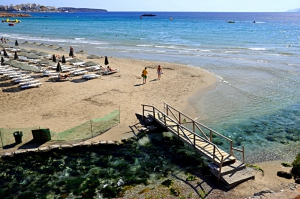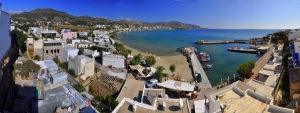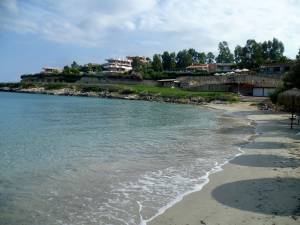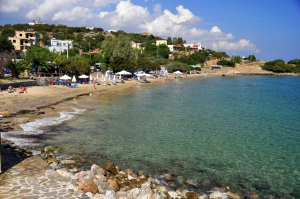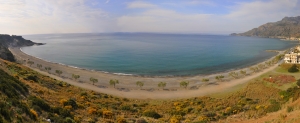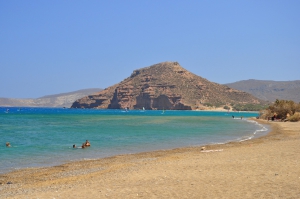Almiros Beach is located 2.5km south of Agios Nikolaos and is the most popular beach in the city. It is shaped near the exit of the Almiros River, which empties on the south part of the beach. Next to the beach, the protected wetland of Almiros hosts several rare birds, towering eucalyptus trees, reeds, and some palm trees.
The sea is a main attraction for children who can play, run and roll about in the sand to their heart’s content. They make friends and feel the healthy power of nature. Crete has a wide variety of beaches that are safe and ideal for families with children.
Children have an excellent relationship with water, from their nature, and nearly always get excited by the sea. This is one of the most fruitful periods in the life of everyone, children and parents, so don’t allow it to pass by.
Children, when small (up to 3yrs) need constant supervision, but when they get three or more, they love water games and become more independent. When they grow further and start diving, snorkeling, or fishing, their love for the sea and the environment grows even more.
To achieve all these and make them easier, it is essential to ensure the existence of conditions with a high sense of safety. Thus, it is desired that the beaches meet some specific conditions that will make life easier for parents.
The beaches, ideal for children, are quiet, good to be shallow, wave-sheltered, sandy or at least without rocky bottom, and close to hotels and restaurants. In Crete, many beaches are ideal for our young friends, the most important of which are presented below.
To the south of Chania, our small friends can have the time of their lives on the shallow sandy beaches of Frangokastello, Paleochora, Elafonissi, and Falassarna. To the north, well out of the north wind, there is a choice of beautiful beaches: Marathi, Chrisi Akti, and Kalivaki in Georgioupolis.
In the prefecture of Rethymnon, children can bathe and play at the wonderful beaches of Plakias and Damnoni on the south coast. The wind-protected beaches of Bali and Panormo on the north coast are also children- friendly.
Moreover, around Heraklion there are many beaches that are greatly appreciated by local families, Kastri and Tsoutsouras, being two of the most popular ones on the south coast. The well-equipped beaches of Agia Pelagia, Gouves, Chersonissos, and Stalida on the north coast also ensure an enjoyable swim and much fun for our little friends.
In Lassithi prefecture, near Agios Nikolaos in Mirambello Bay, there are a number of hidden beaches that are perfect for children, though the longer and wider beaches of Makrigialos, Kouremenos, and Chiona are a very common family destination.
Makrigialos is located 58km southeast of Agios Nikolaos and 23km east of Ierapetra. It is a large village, located near the exit of the lush canyon of Pefki. Being initially a humble harbor with no roads in the ‘50s, Makrigialos has faced strong growth and has become the largest tourist destination in the region. It actually consists of two settlements, Makrigialos and Analipsi, which are now united.
Kokkini Hani is located 15km west of Heraklion, west of Vathianos Kambos. The area is a very well-developed resort, surrounded by the many crops cultivated in the plain of the area. The name of the site means “Kokkinis’s Inn” and is taken after an inn that operated here in the early 1900s, by someone called Kokkinis.
The seaside resort of Loutraki is located 16km east of Chania, near the military base of Souda. Loutraki and Marathi are the two main touristic destinations in the region.
In front of the touristic settlement, there is a nice sandy beach with turquoise waters. The sea surface is mainly flat because the beach has an easterly orientation. while winds in Crete come mainly from the west. The beach is organized with umbrellas, sunbeds, and water sports.
Tsoutsouras or Tsoutsouros (deriving from the Venetian word Zuzzuro) is located 63km south of Heraklion, at the exit of the imposing Gorge of Mindris. It is built on the site of the ancient city Inatos, which was the port of Priansos (located near Kasteliana village).
Chiona means carob storehouse in the Cretan dialect and is taken after the storehouses that were usually built next to the shore in order to transfer carobs with ships. Indeed the area was known for trading carobs. Here you can have a perfect day, especially if you combine your visit to Chiona with eating at the famous local fish taverns of Batis and Amanakis.
The beach is the longest in the area with a length exceeding 1.5km, bounded on the north by the Cape Tenta and on the south by the Cape Plaka. It has fine brown sand, shallow turquoise waters, and several tamarisk trees around it. It is slightly organized in some areas with umbrellas, showers, and beach bars.











